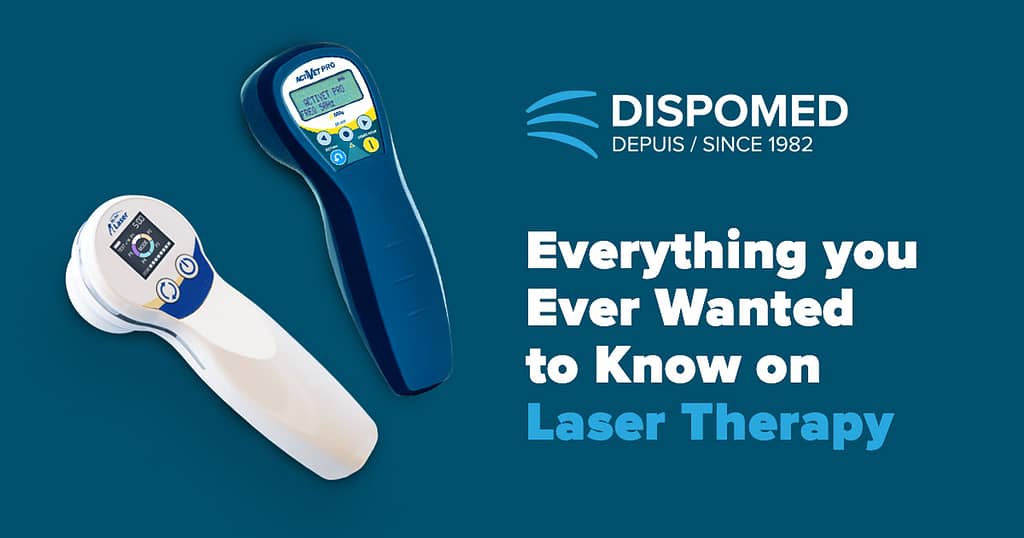Laser therapy has quickly become a trusted tool in many veterinary clinics, offering a non-invasive way to reduce pain, accelerate healing, and support recovery in a wide range of patients. Yet despite its growing popularity, questions remain among veterinary professionals about how it works, when to use it, and what to look for in different types of laser systems.
In this article, we’re answering the most frequently asked questions about low-level laser therapy (LLLT) to help you make informed decisions for your patients and your practice.
Whether you’re new to laser therapy or looking to expand your knowledge, this guide covers:

What is low-level laser therapy?
Also known as soft laser, laser therapy is a form of phototherapy used to stimulate tissue repair and provide pain management. The laser uses focused red and infrared light to stimulate tissue at and below the surface of the pet’s skin.
The biochemical effect of the low-level light increases the production of cellular energy and thus promotes cellular regeneration, production of collagen for tissue repair, and vascular dilation and synthesis for better circulation. Light from the low-level laser also encourages production of the body’s natural pain-relievers.
What is the history of LLLT in veterinary medicine?
The first low-level laser was developed in 1960 and early testing showed an increase in the speed and overall success of the healing process when it was used. Originally used for wound repair, clinical trials done throughout the 1970s showed the applicability of the low-level laser in therapy to be more widespread than previously thought. The 1990s came with the invention of more powerful and effective versions of the low-level laser, eventually increasing its popularity in the field of rehabilitation.


What conditions are most often treated with laser therapy?
Low-level laser can be used to treat a myriad of conditions, but within the realm of rehabilitation, it is used mainly on musculoskeletal injuries, soft tissue injuries (sprains and strains), and arthritis. It also helps to release tight muscles, stimulate nerve regeneration, reduce inflammation, and aid in pain management.
- Arthritic Pain
- Hip Pain
- Musculoskeletal Pain
- Myofascial Pain
- Stress
- Pain
- Bruising
- Edema
- Hematomas
- Lesions
- Tendon, ligament injury, and soreness
- Traumatic and overuse injuries
- Scar Tissue
- Ulcers and other persistent non-healing wounds
- Splints
- Strains
- Sore back
- Ankle, hock injuries
- Stifle injuries
- Bone chips
- Hoof conditions: abscesses, bone spurs, inflammation, navicular, ringbone and laminitis
- Inflammatory conditions: acute or chronic otitis (ear problems), anal gland inflammation, periondontitis (gingivitis, hot spots, lick granulomas, idiopathic cycstitis (bladder inflammation), sinusitis, rhinitis (nasal problems)

Pulsed vs. continuous wave lasers: what’s the difference?
In general, laser diodes are either continuous wave or pulsed. The continuous wave (CW) diodes emit laser energy continuously, hence the name.
Pulsed diodes emit a radiation impulse with a high amplitude (intensity) and duration which is typically extremely short: 100-200 nanoseconds. Continuous wave lasers produce a fixed level of power during emission.
Although lacking the high peak power of a “true” or “super” pulsed laser, most continuous wave lasers can be made to flash a number of times per second to simulate pulse-like rhythms by interrupting the flow of light rapidly as in turning a light switch “off” and “on.” True or super pulsed lasers, as the names imply, produce a brief high-power level light impulse. It is the high-power level achieved during each pulse that drives the light energy to the target tissue.
The peak power of a true or super pulsed laser is quite high compared to its average pulse power. By using true or super pulsed lasers, one is able to more effectively drive light energy into tissue. The laser and electronic technologies required to use pulsed diodes are more advanced and the diodes themselves are more expensive than the continuous wave diodes. This is why over 90% of the therapeutic lasers in the North American market are low power continuous wave lasers. Some of these lasers provide power literally at the same level as an inexpensive laser pointer costing around $30.

Can laser therapy be used on every patient?
Pets experiencing pain from their condition may find relief from laser therapy treatments. The biochemical effect of the low-level laser boosts the body’s production of endorphins. Low-level laser therapy is another great way to treat the source of the pain, thereby making it less likely that the pet will need additional pain-reducing medication.
Bringing the Power of Laser Therapy to Your Practice
Low-level laser therapy continues to evolve as a valuable modality in veterinary medicine, offering safe, effective, and evidence-based support for a wide range of conditions – from post-surgical recovery to chronic pain management. Understanding the science behind LLLT, knowing which patients benefit most, and selecting the right equipment are key steps to maximizing its clinical impact.
If you’re considering integrating laser therapy into your practice – or looking to get more from your current system – we’re here to help. Contact us today to speak with a specialist, request a demo, or explore training options tailored to your team’s needs.
Empower your practice with the tools to deliver faster healing and better outcomes—because every patient deserves the best care.
Reference: Information in this article was adapted from the Multi Radiance Veterinary FAQ, a trusted resource for understanding the clinical use of laser therapy in veterinary settings.





